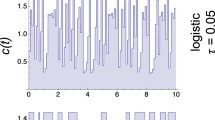Abstract
Traditional population models describe changes in population size as a function of changes in the resources. Such first-order models cannot describe certain properties of population dynamics. General models with delays can account for all the observed dynamic complexities but are judged overgeneralized. It is proposed that the simplest model of intermediate complexity that explains such dynamic properties is a second-order model, which describes population dynamics as a function of a physiological variable, the dynamics of which in turn depends on resources. Data on accelerated decline of populations in the absence of food from experiments with brown and green hydra as well as literature data support the arguments.
Similar content being viewed by others
Literature
Arditi, R. and L. R. Ginzburg. 1988. “Reconciling Time Scales in Predation Theory”.J. Anim. Ecol. (submitted).
Beddington, J. R., C. A. Free and J. H. Lawton. 1976a. “Concepts of Stability and Resilience in Predator-Prey Models”.J. Anim. Ecol. 45, 791–816.
—, M. P. Hassell and J. H. Lawton. 1976b. “The Components of Arthropod Predation. II—The Predator Rate of Increase”.J. Anim. Ecol. 45, 165–185.
Chapman, R. N. 1928.Animal Ecology. New York: McGraw-Hill.
Cushing, J. M. 1977.Integrodifferential Equations and Delay Models in Population Dynamics. Berlin: Springer-Verlag.
Ginzburg, L. R. 1986. “The Theory of Population Dynamics: I Back to First Principles”.J. theor. Biol. 122, 385–399.
Hutchinson, G. E. 1978.An Introduction to Population Biology. New Haven: Yale University Press.
May, R. R. 1974.Stability and Complexity in Model Ecosystems. New Jersey: Princeton University Press.
McCauley, E. and W. W. Murdoch. 1987. “Cyclic and Stable Populations: Plankton as Paradigm”.Amer. Natur. 129, 97–121.
Murdoch, W. W. and E. McCauley. 1985. “Three Distinct Types of Dynamic Behaviour Shown by a Single Planktonic System”.Nature 316, 628–630.
Nicholson, A. J. 1955. “An Outline of the Dynamics of Animal Populations”.Austr. J. Zool. 2, 9–65.
Ricklefs, R. E. 1979.Ecology. 2nd edition. New York: Chiron Press.
Slobodkin, L. B. 1954. “Population Dynamics inDaphne obtusa Kurz”.Ecol. Monogr. 24, 69–88.
— 1964. “Experimental Populations of Hydrida”.J. Anim. Ecol. 33 (Suppl.), 131–148.
Smith, F. N. 1954. “Quantitative Aspects of Population Growth”. InDynamics of Growth Processes, E. Boell (ed.) New Jersey: Princeton University Press.
Tsuchiya, H. M., J. F. Drake, J. L. Jost and A. G. Fredrickson. 1972. “Predator-Prey Interactions ofDictyostelium discoideum andEscherichia coli in Continuous Culture”.J. Bacteriol. 110, 1147–1153.
Volterra, V. 1926. “Variazioni e Fluttuazioni del Numero D'Individui in Specie Animali Conviventi”.Mem. Acad. Lincei. 2, 31–113.
Author information
Authors and Affiliations
Rights and permissions
About this article
Cite this article
Akçakaya, H.R., Ginzburg, L.R., Slice, D. et al. The theory of population dynamics—II. Physiological delays. Bltn Mathcal Biology 50, 503–515 (1988). https://doi.org/10.1007/BF02458849
Received:
Revised:
Issue Date:
DOI: https://doi.org/10.1007/BF02458849




